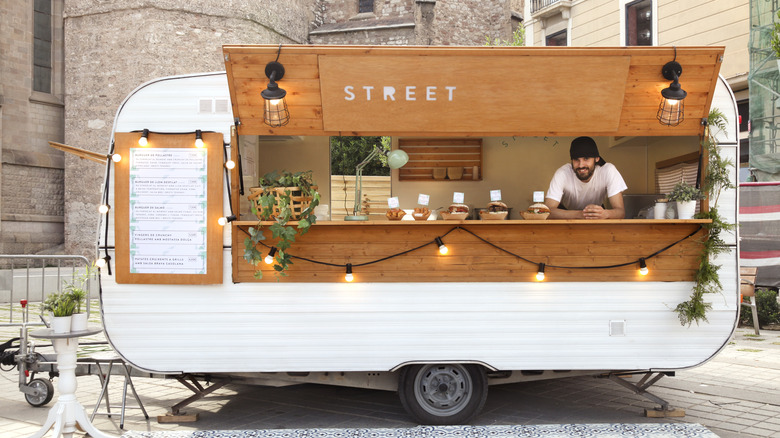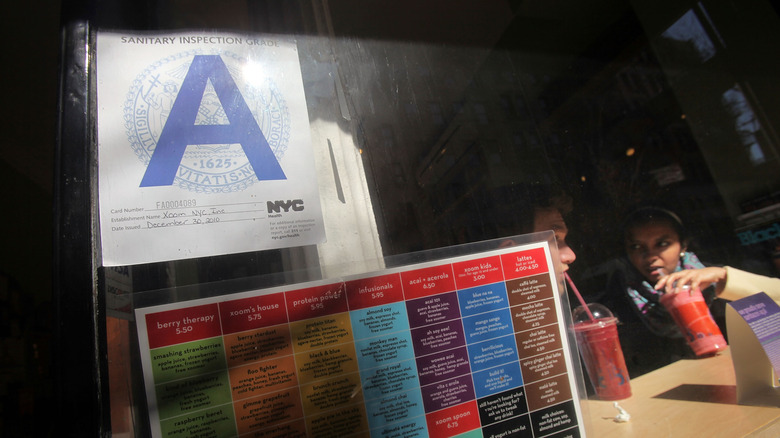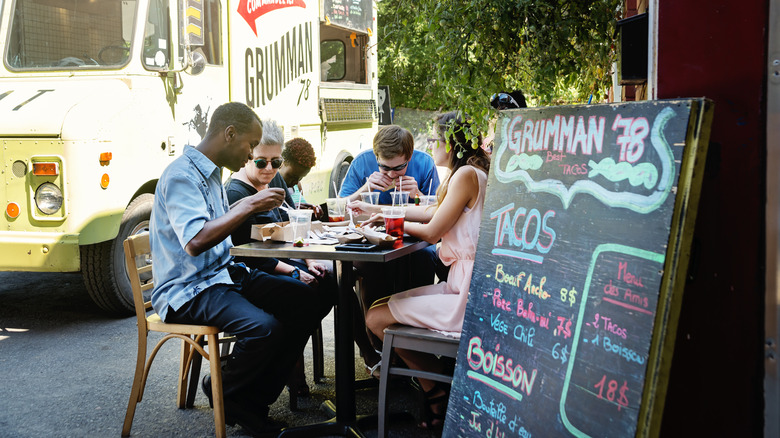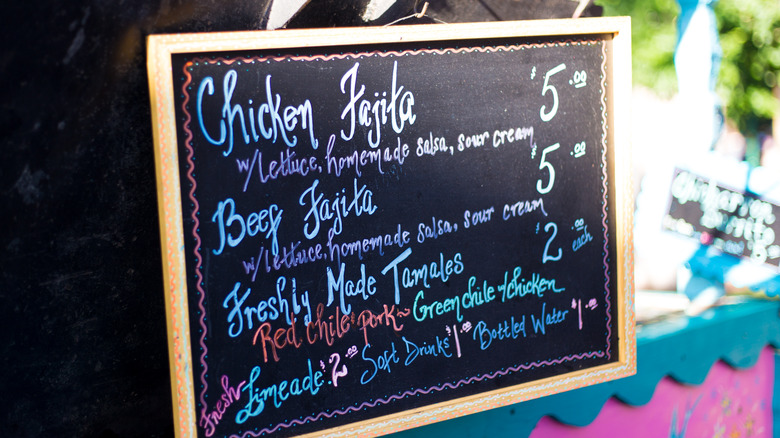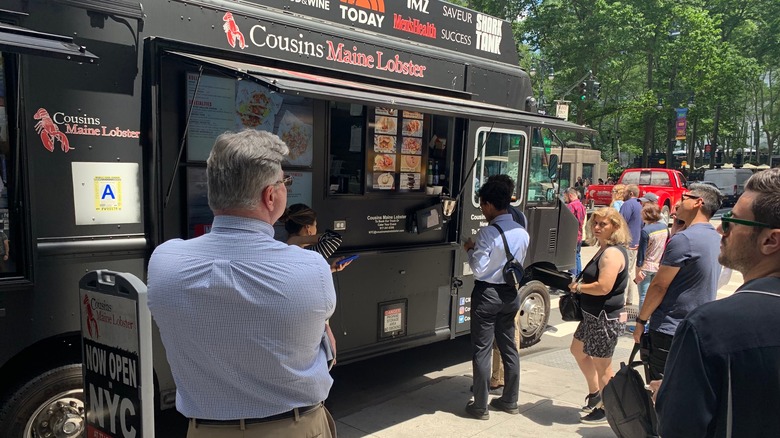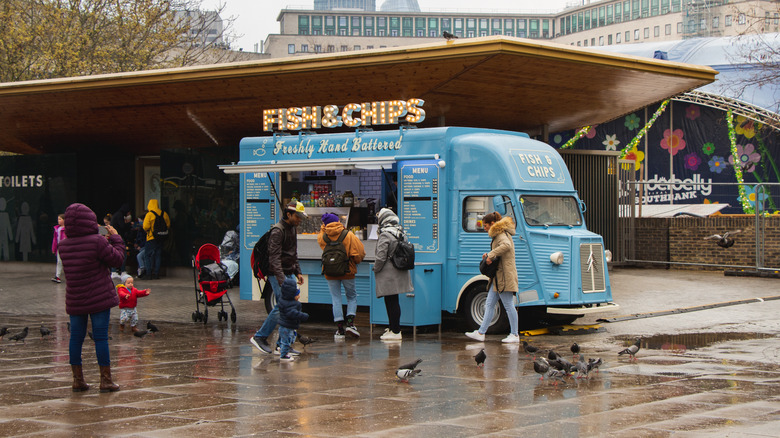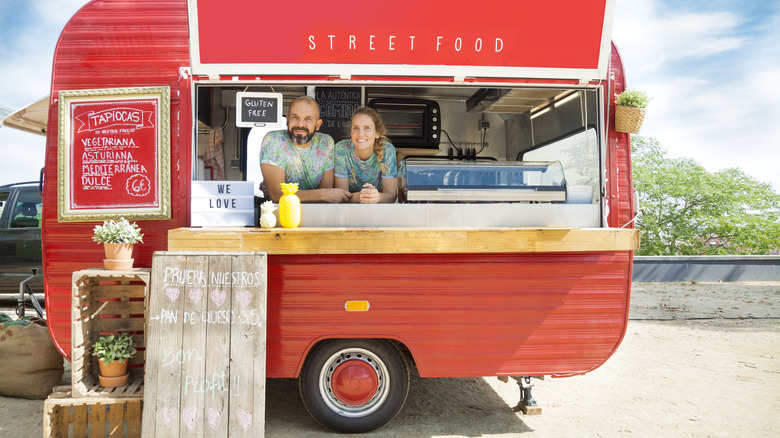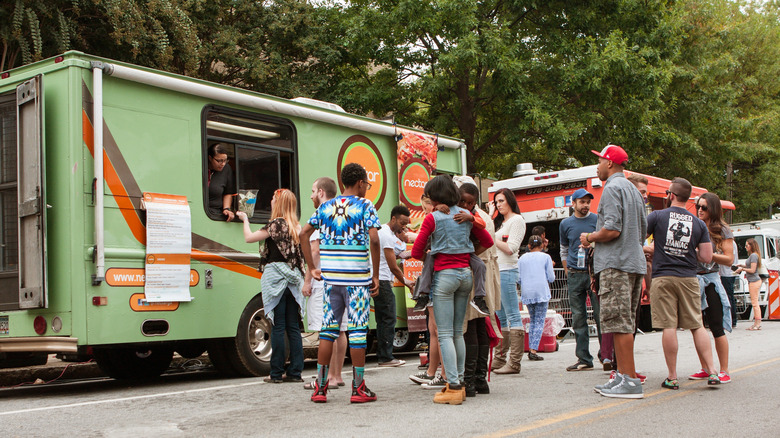If You're Thinking Of Launching A Food Truck, Get Ready For Headaches
The food truck industry has seen remarkable growth since 2017 and according to Toast, has an average annual market size increase of 7.9%. This steady influx of food trucks is significantly reshaping the culinary landscape, not just in cities where street foods like hot dogs have long been a staple but also in small towns across America. The concept of running a food truck, with the ability to move from event to event and interact with diverse groups of people, carries a certain bohemian charm. However, the process of starting and operating a food truck involves more complexities than you might initially think.
To understand these unique challenges, we spoke with Kenny Nadeau, owner of Uncle Kenny's BBQ & Catering, and the food truck, Uncle Kenny's Take-Away. Nadeau, who previously ran a St. Louis-style brick-and-mortar restaurant, has transitioned to operating a food trailer which he pulls behind his truck. Over the past year, as his food business has grown, he has gained firsthand insight into how running a food truck differs from managing a traditional restaurant, each with its own distinct set of challenges.
While food trucks offer a flexible and potentially lucrative business model, they also require careful planning, adaptability, and an understanding of the nuances of mobile food service. From navigating logistical challenges to adapting to various local regulations and building a loyal customer base, the journey of a food truck operator is filled with unique obstacles full of headaches, especially in the beginning.
Providing food for an event requires early promotion
The mobility of food trucks is indeed one of their greatest assets, allowing them to bring diverse culinary offerings to various events. However, this same flexibility also places a significant onus on effective communication and promotion to potential customers. Often, food truck owners have to depend on event organizers for this.
Timely and clear communication is critical for the success of a food truck at an event. It's essential for attracting customers and maximizing the opportunity presented by the event. To achieve this, food truck owners must stay on event planners right from the booking stage. Collaboration increases the likelihood of effective communication about the food truck's presence, while poor marketing from event planners can result in poor sales.
Consider a Fourth of July event scheduled for lunchtime. If food trucks are scheduled to arrive, it's crucial for the event planners to inform potential attendees about their availability. Failing to do so could result in attendees choosing to eat beforehand — or bringing their own food. Both the truck and attendees miss out.
Kenny Nadeau shared that this has happened to his food truck, and one particular incident was due to someone forgetting to post a menu in advance for attendees. He explained, "We did an event one time where they didn't know what food truck [was arriving]. They're supposed to post the menus up in advance so people know what food truck's coming to kinda get people thinking, 'yes, I want barbecue.'"
Expect to make lots of shopping trips
Food trucks simply don't have a whole lot of storage space, and unless a food truck also has a restaurant hub, this means that food truck owners will make plenty of shopping trips to stores. These visits can feel daunting, especially compared to a restaurant, which often gets its deliveries straight to the restaurant to be stored at hand. However, since food trucks move, delivering to a specific spot is a challenge. Not to mention, storing all of the food can be a headache at best or impossible with an inherent lack of space.
In a food truck, there needs to be ample room to cook, prep, serve, and store food. Balancing all of these will be a continuous process that may change based on supply and demand. Another struggle with making shopping trips rather than accepting deliveries is that the food supply is dependent upon what is actually available in the store. Kenny Nadeau told us that, for him, that frequently means brioche buns are a tough find. It also means that you're not getting the discount of purchasing food in bulk but rather paying the same retail prices that home cooks pay for regular grocery items when shopping for their family.
Food trucks are held the same regulations as restaurants
If you've ever approached a food truck and wondered just how clean it could be, you can rest easy because food trucks are held to the very same regulations as restaurants. This means that food truck owners need the same licensing and inspections your favorite restaurants must abide by. While working with the health department may feel daunting to new food truck owners, and it can certainly be intimidating, the process is in place to ensure that food trucks maintain the same standards of serving healthy, delicious food even while on the road.
Scoring low on these inspections may be a red flag that customers shouldn't visit your food truck, but transforming this potential headache into a manageable aspect of running a food truck involves shifting the understanding of what your health department does. They aren't there to be a bother; as Kenny Nadeau explained, they want to help and be a resource in ensuring that food trucks operate with the highest standards of cleanliness and food safety.
You'll want to be judicious in choosing menu items
When selecting top-notch items for your food truck, it's crucial to offer dishes that maintain their peak quality. If you're considering meals that require lengthy cooking times but don't hold up well, you might instead need to get inventive with your cooking methods. For example, since he has a barbecue food truck, Kenny Nadeau serves brisket as part of his menu. He believes brisket is the true indicator of the quality of BBQ someone offers. However, preserving the quality of smoked brisket in the conditions of a food truck can be challenging. All told it's best to opt for menu items that can be freshly cooked each day or stored in the food truck's fridge while still retaining their high quality throughout the day.
Another vital factor in food truck menus is the available space for food preparation. If a menu item demands extensive cooking and prep time and also occupies a significant portion of your kitchen space, it might be more practical to exclude it from your food truck's menu. A victim of space in Nadeau's food truck: sweet tea. He lamented, "Our sweet tea was very popular [in the restaurant]. There's just no way to put a tea brewing machine in there on the counter and having the extra water to brew tea." Making exclusionary choices like these can be difficult, but the logistics of a food truck's limitations must be considered when preparing your menu.
Look for items you can use in multiple ways
As Kenny Nadeau noted, the strategic selection of versatile menu items is especially crucial in the compact environment of a food truck, where every inch of space counts. But the same consideration is crucial for your raw and prepped components. By choosing ingredients that can be transformed into multiple menu offerings, food truck operators can maximize their limited resources. For instance, Nadeau's choice of coleslaw over potato salad is a purely practical one. The coleslaw's adaptability, serving as both a standalone side and a complementary addition to other dishes like spring rolls and spicy chicken sandwiches, showcases its utility. You may find that choosing only items that serve multiple functions and work best for your food truck situation may result in a smaller menu, but this also means it's easier to maintain quality, efficiency, and supply.
This concept is not unique to Nadeau's food truck. Many mobile eateries adopt this approach, using ingredients that serve dual purposes. Macaroni and cheese, for example, is a popular side that can be reimagined as a main component in a variety of creative dishes. Similarly, French fries are a classic side that can be elevated into the star of a dish, such as loaded fries topped with various ingredients or even a poutine.
Using technology can be a bear for advertising
The technological aspects of running a food truck can be challenging, especially if you're not already tech-savvy or well-versed in social media. While participating in self-promotional events is beneficial, leveraging social media is another effective strategy to attract customers. It serves as a key platform for keeping your followers informed about your truck's location. Regularly sharing a schedule, revealing what food truck festivals you'll pull up to, or at least posting appetizing photos of your dishes and menu can significantly boost your visibility and customer engagement.
However, it's important to acknowledge that using social media effectively, particularly if it's new to you, requires a significant investment of time and effort. Learning the nuances of different platforms, understanding what content resonates with your audience, and maintaining a consistent presence can be almost as demanding as a separate job. For food truck owners, this means balancing the art of culinary creation with the science of digital marketing — a challenge that, when mastered, can greatly enhance the success of a food truck business. Taking time before you get started to understand the social media landscape, which platform to invest your time on, and how to use it will make the transition to using these tools much easier.
Long lines look great but harm customers
When you approach a cluster of food trucks and see one with a bustling queue, it's natural to assume that this truck must be serving something special. A long line often signals popularity and high demand, suggesting that the food is worth the wait. This kind of visual appeal can be excellent advertising and might lead to increased revenue. However, while a lengthy line might benefit your bottom line, it's not always in the best interest of your customers.
Finding the right balance between creating the appealing visual of a busy truck and ensuring customers don't wait too long is crucial, particularly for food trucks serving lunch to customers on tight schedules. If the wait is too lengthy, it could deter customers, especially those with limited time, such as office workers on a lunch break. Striking this balance requires time, practice, and a keen understanding of operational efficiency and your own customer service skills.
Ultimately, the goal is to provide the best possible customer experience. This doesn't necessarily mean having a long line, even if it might seem visually attractive or indicative of success. Efficient service, quality food, and a reasonable wait time are key elements in ensuring customer satisfaction and fostering repeat business. It's about finding a sweet spot where popularity doesn't compromise the quality of the customer experience. After all, if you're not respecting the time of your customers, they won't be back.
Weather is unpredictable
Kenny Nadeau's food truck is local to Central Florida, and anyone who has ever visited the region can tell you that there is constantly ultra-unpredictable weather. One minute, it's raining, and the next, the sky is clear with the sun shining intensely. Even a morning weather report can become irrelevant by midday, making it challenging to plan your day on the truck.
Understanding and accepting this unpredictability is key to successful food truck operations in any climate, but especially one where you might be victim to intense weather fluctuation. Rather than being surprised or disrupted by sudden weather changes, it's more effective to plan for various scenarios, including less-than-ideal conditions. This mindset shift is crucial for maintaining a smooth operation and can even become a point of admiration for your customers.
Nadeau notes that regular customers often appreciate the dedication and hard work of food truck operators who persist despite challenging weather. This commitment can encourage loyal customers to make a special effort to visit the truck, regardless of the weather nonsense. Demonstrating resilience and reliability in the face of unpredictable elements can build a strong rapport with customers, fostering a sense of community and loyalty around your food truck, even when its pouring outside.
Your schedule needs to be flexible
As food trucks become more popular and their schedules get busier, flexibility becomes a key factor in successful operations. Kenny Nadeau suggested the strategic approach of leaving a day or two open in your schedule. These open slots can accommodate bookings that need to be rescheduled or even last-minute opportunities. This approach allows for a balance between maintaining a solid schedule and having the flexibility to adapt to unforeseen circumstances.
This strategy is particularly beneficial when unpredictable weather can significantly impact operations. By allocating a few flexible days in your schedule, you create a buffer to accommodate weather-related disruptions. Doing so could be crucial in situations where severe or dangerous weather conditions make it impossible to operate safely.
Having this wiggle room not only helps in managing weather-related issues but also in dealing with other unexpected changes, such as equipment malfunctions or personal emergencies. It ensures that your food truck can maintain a steady flow of business without overcommitting and risking service quality or customer disappointment. This level of planning and adaptability is a hallmark of a well-run food truck business, helping to build reliability and trust with customers and event organizers.
Expect low numbers to start
New food truck owners dreaming of instant financial success are likely to be disappointed, as the reality is that substantial earnings don't materialize overnight. Although food trucks may ultimately result in a good income, this usually isn't the case right from the start. Kenny Nadeau explained, "If I was trying to start a food truck ... and making this my main source business and my main source of income, I would have probably had to go get a job by now."
Nadeau continued by noting that for him, success has come from building a following over 10 years. Since he opened his food truck after having a restaurant for some time, he has a loyal band of regulars who are eager to seek out his food truck and enjoy his BBQ as often as possible. However, for those starting without the foundation of an existing establishment, it takes time to cultivate a steady stream of customers. In this period, some days may feel rewarding, while others might seem like you're barely making ends meet.
Nevertheless, customer numbers and profits are likely to increase with persistent marketing, regular appearances at events, and a commitment to quality. The best strategy to cope with the initial low turnout is to anticipate it. Expecting modest beginnings can help soften the impact of slow days and keep you focused on the bigger picture of steady growth over time.
Still, building up a following is essential
Over time, as a food truck gains popularity, it inevitably attracts regular customers. These loyal patrons often rely on social media updates to track down their favorite food truck for lunch or dinner. Therefore, establishing a routine of visiting the same locations consistently can be highly beneficial. Regular appearances in familiar spots allow food truck owners to interact with the same customers repeatedly, fostering familiarity and building relationships.
This consistent presence and interaction are key in developing a base of regulars. However, it's important to remember that cultivating such a following doesn't happen overnight. It's a gradual process that grows through word of mouth, intentional engagement with customers, and making a concerted effort to become a part of their lives, even in a small way. Building this type of community around your food truck takes time, patience, and genuine connection with the people you serve. And like the profits, it'll probably happen at a slow pace.
Staffing may be a revolving door
The compact nature of food trucks inherently limits the amount of space available for prep, cooking, and serving, which in turn restricts the number of staff needed for operation. Much like a scene from a home improvement show highlighting a cramped bathroom in need of redesign, an overcrowded food truck kitchen is impractical and counterproductive. Consequently, food trucks typically require only a small team to function effectively on a regular basis.
While this smaller staffing requirement simplifies the process of getting the truck up and running, it also means that there are limited positions available for potential employees. This situation can lead to a schedule that offers only limited work hours for each staff member. For some, this part-time schedule might be ideal, but for others seeking full-time employment, it could necessitate looking for additional work opportunities elsewhere.
As a result of these varying needs and limited hours, there might be a noticeable turnover within the food truck's staff. This can sometimes give the impression of a revolving door in terms of who is working the truck at any given time. Managing this aspect of the business requires careful scheduling and an understanding of each team member's availability and employment needs to maintain a consistent level of service and operation.
